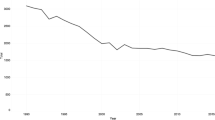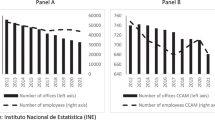Abstract
Spanish financial institutions have been heavily affected by the banking crisis that began in 2008. Many of them, especially Spanish savings banks (or Cajas), had to merge with other institutions or had to be rescued. We address the question of up to what point the nature of competition in this sector has changed as a result of the crisis. Although institutions compete in many ways, we concentrate on their presence in the main street through bank branches open to the public (i.e., retail banking competition). Our measure of inter-firm rivalry is based on a geographical proximity measure that we calculate for the years 2008 (before the crisis) and 2012 (the last available data set). The technical approach is based on multidimensional unfolding, a methodology which allows us to graphically represent the asymmetric nature of such rivalry. These maps visualise the salient aspects of the system during the two dates analysed, and can be understood without a detailed technical knowledge.




Similar content being viewed by others
References
Azofra-Palenzuela V, Santamaría-Mariscal M (2004) El gobierno de las cajas de ahorro españolas. Universia Bus Rev 2:48–59
Bank of Spain (2011) Report on Banking Supervision in Spain, 2010
Burt R (1987) Social contagion and innovation: cohesion versus structural equivalence. Am J Sociol 92:1287–1335
Busing FMTA, Groenen PJF, Heiser WJ (2005) Avoiding degeneracy in multidimensional unfolding by penalizing on the coefficient of variation. Psychometrika 70:71–98
Carroll JD, Wish M (1974) Multidimensional perceptual models and measurement methods. In: Carerette EC, Friedman MP (eds) Handbook of perception. Academic Press, New York
Chen M-J (1996) Competitor analysis and interfirm rivalry: toward a theoretical integration. Acad Manag Rev 21(1):100–134
Chen M-J, Hambrick DC (1995) Speed, stealth, and selective attack: how small firms differ from large firms in competitive behaviour. Acad Manag J 38:453–482
Costa da Cruz R, Starke-Rodrigues FCT (2013) Competitive pressure systems mapping in the Brazilian truck market. Indep J Manag Prod 4(1):148–170
D’Aveni RA (2001) Strategic supremacy: how industry leaders create growth, wealth, and power through spheres of influence. The Free Press, New York
D’Aveni RA (2002) Competitive pressure systems mapping and managing multimarket contact. MIT Sloan Manag Rev 44(1):39–49
De Sarbo WS, Grewal R (2007) An alternative efficient representation of demand-based competitive asymmetry. Strateg Manag J 28(7):755–766
De Leeuw J (2005) Multidimensional unfolding. Entry in the encyclopedia of statistics in behavioural science. Wiley, Hoboken
De Leeuw J, Heiser WJ (1982) Theory of multidimensional scaling. In: Krisnaiah PR, Kanal LN (eds) Handbook of statistics, vol 2. North Holland, Amsterdam
De Rooij M (2012) An application of the mixed effects trend vector model to asymmetric change data with auxiliary variables. Behaviormetrika 39:75–90
Fleiss JL, Levin B, Paik MC (2003) Statistical methods for rates and proportions. Wiley, New York
Fuentelsaz L, Gómez J (2008) ‘Quiénes son mis rivales? Contacto multimercado y asimetría competitiva en la banca española. Universia Business Review, special issue, pp 112–129
González-Moreno A, Sáez-Martínez FJ (2008) Rivalry and strategic groups: what makes a company a rival? J Manag Gov 12(3):261–285
Gower JC (1977) The analysis of asymmetry and orthogonality. In: Barra JR, Brodeau F, Romier G, van Cutsem B (eds) Recent developments in statistics. North Holland, Amsterdam, pp 109–123
Hansmann H (1996) The ownership of enterprise. Harvard University Press, Cambridge
Harshman RA, Green PE, Wind Y, Lundy ME (1982) A model for the analysis of asymmetric data in marketing research. Mark Sci 1:205–242
Heiser WJ, Busing FMTA (2004) Multidimensional scaling and unfolding of symmetric and asymmetric proximity relations. In: Kaplan D (ed) The Sage handbook of quantitative methodology for the social sciences. Sage Publications Inc, Thousand Oaks, pp 25–48
Jansen LKC, Rotondaro RG, Jansen JU (2005) Estratégias de sobrevivência para pequenas e médias empresas em ambientes globalizados: um estudo de caso do setor eletroeletrônico. Gestão & Produção 12(3):405–416
Leydesdorff L, Vaughan L (2006) Co-occurrence matrices and their applications in information science: extending ACA to the web environment. J Am Soc Inf Sci Technol 57:1616–1628
Mar Molinero C, Serrano Cinca C (2001) A multivariate analysis of bank failure in Spain. Eur J Finance 7:165–183
Monsuur H (2005) A square law for power of positions in a network. Oper Res Proc 2004:416–424
Okada A, Imaizumi T (1987) Nonmetric multidimensional scaling of asymmetric proximities. Behaviormetrika 14(21):81–96
Okada A, Tsurumi H (2012) Asymmetric multidimensional scaling of brand switching among margarine brands. Behaviormetrika 39(1):111–126
Real Decreto 2290/1977, de 27 de agosto, por el que se regulan los órganos de gobierno y las funciones de las Cajas de Ahorros
Real Decreto 1582/1988, de 29 de diciembre, de modificación del Real Decreto 1370/1985, en materia de expansión de Entidades de Depósito
Real Decreto-ley 11/2010, de 9 de julio, de órganos de gobierno y otros aspectos del régimen jurídico de las Cajas de Ahorros
Sagarra M, Mar-Molinero C, García-Cestona M (2013) Spanish savings banks in the credit crunch: could distress have been predicted before the crisis? A multivariate statistical analysis. Eur J Finance (forthcoming)
Serra Ramoneda A (2011) Los Errores De Las Cajas. Ediciones Invisibles, Barcelona
Serrano Cinca C, Mar Molinero C, Chaparro F (2004) Spanish savings banks: a view on intangibles. Knowl Manag Res Pract 2:103–117
Schneider JW, Borlund P (2009) Analyzing cross-reference transactions between authors by use of an asymmetric proximity measure and multidimensional unfolding. Proc Am Soc Inf Sci Technol 46(1):1–19
Yang J, Lu L, Xie W, Chen G, Zhuang D (2007) On competitive relationship networks: a new method for industrial competition analysis. Phys A 382(2):704–714
Yang J, Wang W, Chen G (2009) A two-level complex network model and its application. Phys A 388(12):2435–2449
Tversky A (1977) Features of similarity. Psychol Rev 84:327–352
Zhuang D, Yang JM (2008) Simulation of rivalry spread effect over the competitive pressure network. In: Proceeding of IEEE, SMC, Singapore
Acknowledgments
Two anonymous referees and the editors provided extensive comments and suggestions which greatly improved the paper. The authors also acknowledge support from the Projects ECO2010-16760 and ECO2010-21393-C04-01 financed by the Spanish Ministry of Science and Innovation.
Author information
Authors and Affiliations
Corresponding author
Rights and permissions
About this article
Cite this article
Sagarra, M., Busing, F.M.T.A., Mar-Molinero, C. et al. Assessing the asymmetric effects on branch rivalry of Spanish financial sector restructuring. Adv Data Anal Classif 12, 131–153 (2018). https://doi.org/10.1007/s11634-014-0186-2
Received:
Revised:
Accepted:
Published:
Issue Date:
DOI: https://doi.org/10.1007/s11634-014-0186-2




